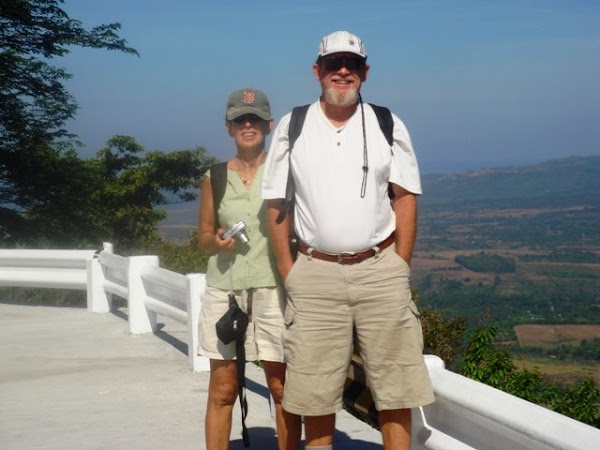Getting the Bottom Cleaned!
One of the reasons Randal and I want to learn to SCUBA Dive is to clean the bottom of the boat, the propeller, and the bow thrusters. If they get clogged with crustaceans and other living things, it either slows us way down and uses more fuel, or it clogs the bow thrusters so they might not work. During our last two trips to Silanguin we could tell the prop was dirty by how slow the boat would go at 1500 rpms. Tuesday morning, one of the local fellows, Glenn, a friend of Jordan’s our current boat helper, came at 9 am so we could go off to cleaner water and he could clean the boat bottom. It was overcast with some rain. But when you are working under water, rain isn’t a problem. Wind and waves would have been the problem, but it was fairly calm. We actually motored over a bit and anchored off shore of Vasco’s Restaurant.
Jordan came too. His job was to be ready to jump into the water to get Glen out if we had to move the boat for any emergency reason. You can’t start the propeller while someone is cleaning it, and to move the boat and control drift or direction, you need to have the boat moving and the propeller running. We had no emergencies and all went smoothly. Jordan went into the water to help clean the sides of the boat. That was good. Unfortunately he had borrowed Randal’s face mask and somehow managed to drop it to the bottom. We’re not sure why, but Glenn decided that the mask was irretrievable because of the current and murk. Oh well, things happen.
After our SCUBA lesson with Audrey I really think I could do the boat bottom cleaning. It isn’t easy scraping all of the barnacles and stuff off, but Randal and I would divide the work and take our time. If we did it on a regular basis, maybe it wouldn’t be so bad. And cleaner water might not generate so much clinging stuff. Oceanography, zoology, geography, cartography…all of the ographies I wish I had studied, then I wouldn’t have to call it “clinging stuff.”

Randal and Glenn in the engine room where Randal is showing Glenn the sea chest. The sea chest takes in all of the water used to cool the engine exhaust, and for the air conditioning and geneset. Creatures, similar to our under the sink creatures, crawl up into it and it gets clogged. Randal was pointing out to Glenn that the opening under the boat needed to be cleaned too, so where about it would be located.
Get Ready ……..

Get Set………

Go!

Going down………………………….

The scuba vest is inflated so you float on the water. You deflate the vest, and that, plus the weights you wear let you stay under the water and not float up to the surface. The trick is to use enough weights and inflate the vest just right so you don’t sink or float back to the surface. Neutrally buoyant is the correct term, I think.

Jordan cleaning the boat sides.
 This little creature, scraped from the bottom of the boat looked like an oyster. My foot with my rope necklace now an ankle thing and my Red Sox rubber bracelet that is way too big for my wrist. Yup, I really do wear that stuff during the season. Worked last year! I bought a real chain for my Red Sox hat charm; the rope one sometimes untied itself.
This little creature, scraped from the bottom of the boat looked like an oyster. My foot with my rope necklace now an ankle thing and my Red Sox rubber bracelet that is way too big for my wrist. Yup, I really do wear that stuff during the season. Worked last year! I bought a real chain for my Red Sox hat charm; the rope one sometimes untied itself. To tell if your anchor is dragging you pick 2 points in the distance and watch if their relationship changes. (The tree and the notch in the mountain to its left.) If it does change, your anchor might be dragging. You have to do this because there are no lines painted on the ocean to tell you if you are in your space. You can use a radar ring on your electronic chart when you are anchored in a cove; it will beep if you move out of that ring. We did that in Hamilo Cove when we traveled to Puerto Galera and anchored over night. But we were too close to shore to make a ring that would work. So we just had to watch. I don’t really understand spatial relationships and need to work on seeing what I am supposed to see.
To tell if your anchor is dragging you pick 2 points in the distance and watch if their relationship changes. (The tree and the notch in the mountain to its left.) If it does change, your anchor might be dragging. You have to do this because there are no lines painted on the ocean to tell you if you are in your space. You can use a radar ring on your electronic chart when you are anchored in a cove; it will beep if you move out of that ring. We did that in Hamilo Cove when we traveled to Puerto Galera and anchored over night. But we were too close to shore to make a ring that would work. So we just had to watch. I don’t really understand spatial relationships and need to work on seeing what I am supposed to see. Job done!
Job done!


No comments:
Post a Comment